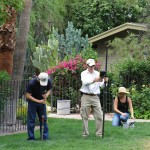June 12, 2015
 Dear CAP Colleagues, Students, and Friends,
Dear CAP Colleagues, Students, and Friends,
We’re heading into summer with some exciting synthesis research funded and underway! Several groups of CAP scientists will analyze long-term data to address specific scientific questions. We expect these projects will contribute greatly to the development of the CAP-IV proposal.
The projects and teams are:
- Using the Survey 200 data to discern influences of climate, plant communities, and land use on decadal patterns of soil properties (Becky Ball and Sharon Hall)
- Studying the structure of food webs and biodiversity patterns, and how they change with land use and climate anomalies (Dan Allen, Heather Bateman, Chris Martin, John Sabo, Jean Stutz, Albert Ruhi)
- How has urbanization in riparian zones on two major streams affected ecosystem service provision? (Dan Allen, Ben Ruddell, Nancy Grimm, Billie Turner, and Xiaoxiao Li)
- Using long-term land cover data to understand how metrics of spatial patterning have changed (WenWen Li and Libby Wentz)
- Statistical synthesis of long-term climatic and land use/land cover datasets (Zhihua Wang and Soe Myint)
- Relating long-term changes in urban biodiversity with changes in human perception and management (Paige Warren, Kelli Larson, Heather Bateman, Susannah Lerman, Sharon Hall, Christofer Bang)
- Determining residential landscaping water requirements in the CAP ecosystem using a water balance model and long-term, experimental yard datasets (Sharon Hall, Enrique Vivoni, and Kelli Larson)
- Synthesis of longitudinal land cover analysis and long term social and environmental trends (Ray Quay, Sharon Hall, Sharon Harlan, Billie Turner, Kelli Larson, Ben Ruddell, Yujia Zhang, and Xiaoxiao Li)
- Time-series analysis of Tempe Town Lake biogeochemistry (Hilairy Hartnett, Monica Palta, and Albert Ruhi)
- Impacts of haboobs and dust storms on the chemistry of Tempe Town Lake, bringing together long-term datasets on atmospheric and aquatic chemistry (Hilairy Hartnett and Pierre Herckes)
In addition, we have five graduate student projects funded through our Grad Grants program, which will also contribute to the corpus of research syntheses we have to work with as we gear up for the renewal. Congratulations to these graduate students:
- Chao Fan – developing new analytical tools to describe urban sprawl and exploring its relationship with the urban heat island
- Ben MacNeille –bacterial communities of the phyllosphere and their mitigation of atmospheric pollution
- Julie Ripplinger – Bottom up and top down social and ecological controls of residential plant communities, using Survey 200 data
- Melinda Weaver – how urban stresses alter behavior of house finches
- Qunshan Zhao – relationship of urban heat island to roof materials
Since my last note, a lot has happened – especially comings and goings. Stevan Earl has stepped down as CAP Site Manager, assuming a position as Data Manager for GIOS. In that capacity, he will continue to work with CAP scientists on getting their data into the database (please put your data into the database!). We welcome Sally Wittlinger, as of May 18, as our new Site Manager! Sally brings a wealth of experience in program and lab management and comes to us most recently from DCDC. Look for a more thorough introduction after she begins work. Our CAP student worker, Mary Munoz Encinas, is graduating from ASU in a few days. Mary has been behind the scenes entering biota data as well as completing her own work using our urban shade tree data.Congratulations to Mary!
Here are some additional CAP LTER highlights:
- We had another very successful and well-attended All Scientists meeting in January, with Kathy Jacobs (formerly Director of the National Climate Assessment and now Director of the UA’s Center for Climate Adaptation Science and Solutions) as our keynote speaker and a distinguished panel discussing the future of Phoenix.
- Planning for the CAP-IV proposal is well underway with Dan Childers at the helm.
- Survey 200 is well underway. We are especially grateful to Lindsey Pollard, who stepped in when Stevan moved to the IT group to ably coordinate the survey.
- Dr David Hulse visited ASU to deliver a special CAP seminar on his excellent work on future scenarios for the Willamette River Basin in Oregon.
- Congratulations to Tony Brazel and Kerry Smith, who were awarded CAP LTER research awards and were honored at a small gathering in April.
- ASU is a recommended recipient of two of the three Sustainability Research Networks (SRN) awards (expected start in late summer/early fall). ASU is the lead institution of the first, the Urban Resilience to Extremes (UREx) SRN (Charles Redman, PI, Nancy Grimm and Mikhail Chester, co-PIs), and is a subawardee for the Urban Water Innovation Network (U-WIN) SRN led by Colorado State (Matt Georgescu, co-PI). Both proposal strongly leveraged CAP. However, both are pending at this writing!
- CAP recently submitted an equipment proposal to replace a vehicle and partially support the acquisition of a new gas chromatograph for trace-gas analysis.
- CAP (Phoenix) is again on the drawing board as a potential urban ‘relocatable’ site for NEON – stay tuned.
- Since last writing, three graduate students affiliated with CAP have or are in the process of defending their dissertations/theses. Join me in congratulating the following:
- Thomas Bleasdale defended his dissertation, “Gardens of justice: Food-based social movement in south and west Phoenix,” on April 16th (Sharon Harlan, Chair; Bob Bolin and Kevin McHugh, committee members)
- Hannah Heavenrich will defend her thesis, “Soil biogeochemical consequences of a ‘sustainable’ urban grassland to shrubland transition,” on May 13th (Sharon Hall, Chair; Kelli Larson and Diane Pataki, committee members)
- Jeffrey Ackley will defend his dissertation, “Rich lizards: How affluence, land cover, and the urban heat island effect influence desert reptiles persisting in an urban landscape,” on May 15th (Jianguo Wu and Brian Sullivan, co-chairs; Soe Myint, Dale Denardo, and Michael Angilletta, committee members)
- CAP REU student, Jessica Jia, successfully defended her Honor’s Thesis, “Quantifying the trade-off between landscape vegetation height, surface temperature, and water consumption in single-family residential houses for a desert city,” this spring (Kelli Larson and Elizabeth Wentz, co-chairs). Congrats to Jessica as well!
A little news about me: Although I will be taking sabbatical during the 2015-2016 academic year, I will mostly be here (staybatical) and will continue to lead CAP in collaboration with Dan, as we begin the process of transitioning leadership. I will also be very busy helping to get the new UREx SRN project underway. In June, I will spend a week at Kellogg Biological Station (one of our sister LTERs) as an ‘eminent ecologist’ (their title) in residence. I will spend a bit of time in New Mexico throughout the year, and have plans for a 4-6-week stay in Stockholm at the Resilience Center late next spring. But I will be completely available for all things CAP, so send me email or give me a call at any time.
Finally, congratulations and thanks go to the authors of the 18 journal articles that have appeared since my December update. These papers are listed below. Please do let us know if we’ve missed any, and as always, remember to keep Cindy and Marcia informed of new journal articles, book chapters, books, or noteworthy presentations—and to acknowledge CAP in your publications.
I wish each of you a productive and relaxing summer.
Nancy
Publications since my December 2014 Director Note:
Abbott, J. K., H. A. Klaiber and V. K. Smith. 2015. Economic behavior, market signals, and urban ecology. NBER Working Paper Series, Working Paper 20959. (link)
Ackley, J. W., M. J. Angilletta Jr., D. DeNardo, B. Sullivan and J. Wu. 2015. Urban heat island mitigation strategies and lizard thermal ecology: Landscaping can quadruple potential activity time in an arid city. Urban Ecosystems DOI: 10.1007/s11252-015-0460-x. (link)
Ackley, J. W., J. Wu, M. Angilletta, S. W. Myint and B. Sullivan. 2015. Rich lizards: How affluence and land cover influence the diversity and abundance of desert reptiles persisting in an urban landscape. Biological Conservation 182:87-92. DOI: 10.1016/j.biocon.2014.11.009. (link)
Bestelmeyer, S. V., M. M. Elser, K. V. Spellman, E. B. Sparrow, S. S. Haan-Amato and A. Keener. 2015. Collaboraton, interdisciplinary thinking, and communication: New approaches to K-12 ecology education. Frontiers in Ecology and the Environment 13(1):37-43. DOI: 10.1890/140130. (link)
Childers, D. L., M. L. Cadenasso, J. M. Grove, V. Marshall, B. McGrath and S. T. Pickett. 2015. An ecology for cities: A transformational nexus of design and ecology to advance climate change resilience and urban sustainability. Sustainability 7(4):3774-3791. DOI: 10.3390/su7043774. (link)
Gifford, M., J. Liu, B. E. Rittmann, R. Vannela and P. Westerhoff. 2015. Phosphorus recovery from microbial biofuel residual using microwave peroxide digestion and anion exchange. Water Research70:130-137. DOI: 10.1016/j.watres.2014.11.052. (link)
Ibes, D. C. 2015. A multidimensional classification and equity analysis of an urban park system: A new methodology and case study application. Landscape and Urban Planning 137:122-137. DOI: 10.1016/j.landurbplan.2014.12.014. (link)
Marusenko, Y. Y., F. Garcia-Pichel and S. J. Hall. 2015. Ammonia-oxidizing archaea respond positively to inorganic nitrogen addition in desert soils. FEMS Microbiology Ecology 91(2):1-11. DOI: 10.1093/femsec/fiu023. (link)
McHale, M., S. Pickett, O. Barbosa, D. Bunn, M. Cadenasso, D. Childers, M. Gartin, G. Hess, D. Iwaniec, T. McPhearson, M. Peterson, A. Poole, L. Rivers, S. Shutters, and W. Zhou. 2015. The new global urban realm: Complex, connected, diffuse, and diverse social-ecological systems. Sustainability 7: 5211-5240. (link)
Metson, G. S., D. M. Iwaniec, L. A. Baker, E. M. Bennett, D. L. Childers, D. Cordell, N. B. Grimm, J. M. Grove, D. A. Nidzgorski and S. White. 2015. Urban phosphorus sustainability: Systematically incorporating social, ecological, and technological factors into phosphorus flow analysis.Environmental Science & Policy 47:1-11. DOI: 10.1016/j.envsci.2014.10.005. (link)
Rudd, B. T. and H. L. Bateman. 2015. Reptile use of trails in the Phoenix mountain parks. Herpetological Review 46(1):15-17.
Shaffer, S. R., W. T. Chow, M. Georgescu, P. Hyde, G. D. Jenerette, A. Mahalov, M. Moustaoui and B. L. Ruddell. 2015. Multiscale modeling and evaluation of urban surface energy balance in the Phoenix metropolitan area. Journal of Applied Meteorology and Climatology 54:322-338. DOI: 10.1175/JAMC-D-14-0051.1. (link)
Shuster, W. D., S. D. Dadio, C. E. Burkman, S. R. Earl and S. J. Hall. 2015. Hydropedological assessment of parcel-level infiltration in an arid urban ecosystem. Soil Science Society of America Journal Open Access. DOI: 10.2136/sssaj2014.05.0200. (link)
Volo, T. J., E. R. Vivoni and B. L. Ruddell. 2015. An ecohydrological approach to conserving urban water through optimized landscape irrigation schedules. Landscape and Urban Planning 133:127-132. DOI: 10.1016/j.landurbplan.2014.09.012. (link)
Wang, Z. H. 2014. A new perspective of urban-rural differences: The impact of soil water advection. Urban Climate 10: 19-34. (link)
Wang, Z. H. 2014. Monte Carlo simulations of radiative heat exchange in a street canyon with trees. Solar Energy 110: 704-713. (link)
White, D. D., A. Y. Wutich, K. L. Larson and T. Lant. 2015. Water management decision makers’ evaluations of uncertainty in a decision support system: The case of WaterSim in the Decision Theater. Journal of Environmental Planning and Management 58(4):616-630. DOI: 10.1080/09640568.2013.875892. (link)
Yang, J., and Z. H. Wang. 2014. Physical parameterization and sensitivity of urban hydrological models: Application to green roof systems. Building and Environment 75: 250-263. (link)


